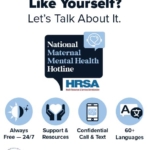While postpartum depression can affect all women, there are certain populations which appear to be at particularly high risk, including women of lower socioeconomic status. These women have limited access to resources and have multiple stressors including housing problems, financial strain, and being a single parent. Researchers recently piloted an intervention randomized controlled trial involving 540 participants at an inner-city hospital in East Harlem, New York. The primary goal of this psychoeducational intervention was to reduce the risk of postpartum depression among black and Latina mothers.
The first part of the intervention occurred in the hospital shortly after delivery. This component of the intervention consisted of a 15-minute, in-hospital review of a pamphlet by a social worker outlining potential triggers of depressive symptoms (e.g., infant colic, episiotomy site pain, urinary incontinence), labeling these events as “normal” aspects of the postpartum experience and providing specific and practical suggestions for their management in the form of simple “to do” lists. A separate page discussed social supports and various local resources were listed. A summary sheet for the partner was provided and reviewed these typical postpartum experiences and stressed the importance of social support for the patient.
The second component of the intervention was a phone call at 2 weeks postpartum during which the social worker assessed the patients’ symptoms, her skills in symptom management, and other needs. The “to do” lists to help alleviate symptoms were reviewed when needed, and the patient and social worker created action plans to address current needs.
A control group of usual care patients received routine postpartum hospital education (i.e., discharge materials, television educational programs on infant care, breastfeeding, and peripartum care). To ensure equivalent contact, patients assigned to the usual care group received a 2-week postparum call to inform them of future surveys and to provide a list of health-related and community resources.
Depressive symptoms were assessed using the 10-item Edinburgh Postnatal Depression Scale (EPDS) with a cutoff score of 10 to indicate significant depressive symptoms. The EPDS was administered at 3 weeks, 3 months, and 6 months postpartum.
Mothers who received the intervention were less likely to screen positive for depression at 3 weeks than those who received usual care (8.8% vs. 15.3%). Women who received the intervention were also less likely than the women receiving usual care as late as 6 months postpartum was lower among treated women (odds ratio, 0.67). These findings persisted even after adjusting for baseline depression.
This is a relatively simple and practical educational intervention which is easy to administer and can lower risk for postpartum depression in a population at high risk for postpartum illness. What is also notable is that while other preventative interventions focus on depression specifically, this intervention focuses primarily on difficult aspects of the normal postpartum experience and on how to increase levels of social support. Another advantage is that the intervention is initiated shortly after delivery, when the woman is still in the hospital. This model was piloted in an inner city population, but it is likely that most mothers – even those with better access to various resources – would benefit from this type of practical and action-oriented intervention.
Ruta Nonacs, MD PhD
Howell EA et al. Reducing postpartum depressive symptoms among black and Latina mothers: A randomized controlled trial. Obstet Gynecol 2012; 119:942-49.








Leave A Comment